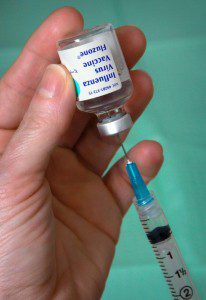

Influenza A (H1N1) 2009 monovalent vaccine is produced by ID Biomedical Corporation of Quebec, a wholly-owned subsidiary of GlaxoSmithKline. The US package insert can be found here (pdf) and the Canadian package insert here. Dosing recommendations for Canada are listed here. Health Canada has also posted a FAQ on the H1N1 vaccine.
The ID Biomedical vaccine is available only in multi-dose vials which contain thimerosal. Each 0.5 ml dose contains 15 micrograms of viral antigen. Other components of the vaccine listed at Health Canada include ‘trace amounts of egg proteins, formaldehyde, sodium deoxycholate and sucrose’. The presence of these compounds reflects how the vaccine is produced: the viral strain is propagated in chicken eggs, purified by centrifugation on sucrose gradients, inactivated with formaldehyde, and disrupted with sodium deoxycholate.
The vaccine has been tested in healthy adults but not in the elderly, adolescents, or children. Approval by both the US and Canada was based on the data from testing of the H1N1 and seasonal influenza vaccines, which are made by an identical process.
In healthy adults, the 2009 H1N1 vaccine produced the typical range of side effects, including pain at the injection site, redness, fatigue, and headache. Twenty-one days after injection of a 15 microgram dose, 93.9% of 66 adults produced an immune response, defined as a hemagglutination-inhibition titer of 1:40 or greater (which correlates with protection against infection). Only slightly higher seroconversion rates (97% of 66 adults) were observed when 21 micrograms of antigen were injected. Clinical trials are ongoing in North America, Europe, and Japan.
The GlaxoSmithKline vaccine is now available in Canada, but is not expected to ship to the US until December.

Pingback: Tweets that mention GlaxoSmithKline influenza H1N1 vaccine approved -- Topsy.com
Pingback: uberVU - social comments
The non-adjuvanted vaccine contains Thimerosal 50 µg per 0.5 mL dose. Isn't that very high for infants? My son is eight months old, healthy, and we have not had him vaccinated so far. But with some travel plans coming up soon, we are considering the vaccine for him. Any guidance on the effects of thimerosal in infants? I feel very skeptical about any amount of mercury being injected into infants.
I understand your skepticism. I suggest you read the following
articles and come to a decision. These include an article on mercury:
http://bit.ly/35jQQO. Although it's focused on autism it does provide
background information. It is my understanding that we are exposed to
far more mercury in the environment than we receive from vaccines.
There is also a good FDA summary of mercury in vaccines here:
http://bit.ly/336VRe. Also look at this summary of mercury levels in
infants: http://bit.ly/4n6qy1. There aren't any data which would
indicate that thimerosal causes any neurodevelopmental disorders; but
it's never possible to rule out all potential side effects. In the US,
a preservative-free version of the inactivated influenza vaccine
(contains trace amounts of thimerosal) is available for use in
infants, children and pregnant women. I suspect that we will
eventually have all mercury-free vaccines in the near future.
I believe the FDA signs off on each and every batch of H1N1 vaccine made by the vaccine plants in the United States. (source http://wfmz.com/view/?id=1297582)
Who signs off on the vaccine made in Canada for export to the USA? Is it the U.S. regulator or the Canadian regulator? Do they both insist on equally rigorous quality standards?
Thank you very much for the additional information you provided. This would be useful for us to decide. Could I also please request you for your opinion on this paper ( http://bit.ly/2sJK65 )?
The FDA signs off on vaccines made in Canada, or any other country. I
don't know if local regulators also intervene.
In that study relatively high levels of thimerosal were needed to have
an effect on cultured cells. Concentrations of thimerosal that induced
toxic effects ranged from 1 μM (405 μg/l) to 250 μM (101 mg/l). As the
authors write, “Much lower concentrations are reached during normal
vaccination, when thimerosal-containing vaccines are used.” Similar
results have been confirmed in other studies. This, coupled with the
fact that the blood half life of mercury is about a week, means it's
probably not correct to assume that similar toxic effects would occur
in humans.
The FDA signs off on vaccines made in Canada, or any other country. I
don't know if local regulators also intervene.
In that study relatively high levels of thimerosal were needed to have
an effect on cultured cells. Concentrations of thimerosal that induced
toxic effects ranged from 1 μM (405 μg/l) to 250 μM (101 mg/l). As the
authors write, “Much lower concentrations are reached during normal
vaccination, when thimerosal-containing vaccines are used.” Similar
results have been confirmed in other studies. This, coupled with the
fact that the blood half life of mercury is about a week, means it's
probably not correct to assume that similar toxic effects would occur
in humans.
Can the vaccines be given to child aged 4 yrs, when she is having a normal cold..? should i wait till her running nose is over..